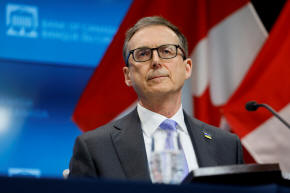Once feted for pandemic heroics, world's central banks now face an
uneasy crowd
 Send a link to a friend
Send a link to a friend
 [June 17, 2022] By
Howard Schneider, Julie Gordon and Leika Kihara [June 17, 2022] By
Howard Schneider, Julie Gordon and Leika Kihara
WASHINGTON (Reuters) - Global central
bankers, who shared the limelight for skirting a pandemic-driven
depression with quick action two years ago, are now stumbling through
the aftermath as they try to quell an inflation surge none predicted or
have been able to forestall.
If their response to the economic crisis triggered by the pandemic
seemed bold and forward-looking, with its laundry list of new programs
and massive monetary stimulus, the last few months have been an erratic,
even awkward phase of failed forecasts, embarrassing mea culpas,
increased political scrutiny and some evidence of lost trust.
Managing inflation is core to a central bank's mission, and from major
players like the U.S. Federal Reserve and the Bank of Japan to regional
institutions like the Bank of Canada and the Reserve Bank of Australia,
recent events have dealt a blow to their credibility as they play catch
up with policy and, in the process, raise the likelihood of recession.

"They had horse blinders on. They didn't want to entertain any talk of
stable or upside risk to inflation in response to massive stimulus
around the world, government and monetary," said Derek Holt, head of
capital markets economics at Scotiabank in Toronto. "I think they had
that evidence even as 2020 unfolded," yet held onto emergency programs
for another year, and discounted an initial rise in inflation as
transitory.
The result: Over little more than a week the Fed has whipsawed financial
markets with a 75-basis-point interest rate increase, its first hike of
that size since 1994; the European Central Bank scrambled towards new
emergency plans to control government bond spreads; the Swiss National
Bank approved an unexpected rate hike; Bank of England forecasts hinted
at a developing stagflation; and Bank of Japan Governor Haruhiko Kuroda
was forced to apologize after stinging criticism of remarks that
households had become "accepting" of higher prices.
Kuroda's predicament was emblematic.
Inflation in Japan crept just over 2% on an annual basis in April, low
compared to the more than 8% increases in consumer prices seen recently
in the United States, for example, and effectively meeting the BOJ's 2%
target after decades of concern about the opposite problem of deflation.
Yet the notion of households accepting higher prices proved taboo,
something that central bankers and elected officials across the world
are fast relearning after a generation when prices were held down by a
variety of forces, including globalization, that the pandemic may have
eroded.

"Every one of these central banks is operating in some kind of risk
management framework and really since the (2007-2009) financial crisis
... the race was who was going to outease the other" in order to sustain
growth and jobs in a low and even falling price environment, said Ed Al-Hussainy,
a senior rates analyst with Columbia Threadneedle. "Now that is going in
reverse ... The risk of error has shifted to the other side of the
street," in the form of inflation that threatens to stay higher and take
public wage and price expectations with it.
BLINDSIDED
Critics say the central banks themselves are to blame for keeping
interest rates too low for too long, and printing too much money for the
economy to absorb - particularly an economy in which the supply of goods
and services suffered its own setbacks.
Central bankers argue that much of the current price shock is beyond
their control, with inflation made more intense and persistent by events
such as the Ukraine war or the still uncertain return of China to its
place in the global goods supply chain.
[to top of second column] |

Bank of Canada Governor Tiff Macklem takes part in a news conference
in Ottawa, Ontario, Canada April 13, 2022. REUTERS/Blair Gable/File
Photo

Whatever the causes, the impact has been felt acutely by households. Blindsided
by rising food and energy prices they were told would be temporary, faith has
begun to erode that central banks will hit their typical 2% inflation targets
any time soon - a worrisome development that's begun shaping central banks' own
reactions.
After the Fed unveiled its large rate hike on Wednesday, Chair Jerome Powell was
blunt in tying the historical action to fears the Fed was losing the battle in
shaping public expectations about inflation.
Some economists downplay such expectations, measured in surveys of households,
as being overly sensitive to things like gas and food prices that are excluded
from the "core" inflation trends typically given importance in setting monetary
policy.
But "headline inflation is what people experience," Powell said in a news
conference after the policy decision. "They don't know what 'core' is. Why would
they? They have no reason to. So expectations are very much at risk" the longer
headline inflation stays elevated.
"Central banks have persuaded themselves that longer-term inflation expectations
were the whole story," and took comfort from surveys showing households expect
inflation to fall years into the future, said Karen Dynan, a nonresident senior
fellow at the Peterson Institute of International Economics and a professor at
Harvard University. But "people look backwards too, and there is inertia. They
think about what changes in wages and prices help them keep up," and begin
demanding them in ways that can drive prices and wages higher.
If households are getting less trustful, politicians are taking note as well.

Bank of Canada Governor Tiff Macklem has faced calls for his removal, and the
central bank has promised a public vetting this summer of its mistaken inflation
forecasts. Australia is planning a review of central bank operations after the
Reserve Bank of Australia's misread of inflation led it to start rate increases
in May after saying until late last year that rises in borrowing costs were
unlikely until 2024.
Powell next week will testify twice before lawmakers in the U.S. Congress as
part of his regular biannual monetary policy updates. The sessions will likely
focus on the threat of high inflation and what's become the central question as
interest rates spike and key markets start to slow: How bad will it get?
Maintaining central bank independence "was easier when central banks were making
progress - not when a situation is deteriorating," said Vincent Reinhart, a
former Fed official who is now the chief economist at Dreyfus and Mellon. He
noted that the collective missteps have occurred during "the relatively easier
part of the tightening spell," when rates are rising from near zero and the
price to be paid in terms of slower economic growth and higher unemployment is
not yet apparent.
"What happens when you are closer to the destination ... but the destination is
much less popular. That is where they are headed."
(Reporting by Howard Schneider; Additional reporting by Julie Gordon, Leika
Kihara, Sam Holmes, Balazs Koranyi and Wayne Cole; Editing by Paul Simao)
[© 2022 Thomson Reuters. All rights
reserved.]This material may not be published,
broadcast, rewritten or redistributed.
Thompson Reuters is solely responsible for this content.
 |